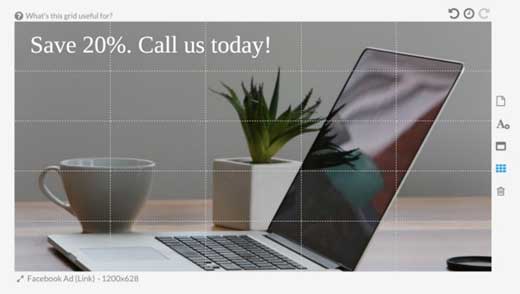
Welcome to Help Computer Guides
Welcome to HelpComputerGuides, trusted informative guides for your everyday

How to create images for online advertising
Written by: Darren Hignett
A great way to reach your target audience is to use online advertising such as Facebook or LinkedIn Ads but, you can quickly burn through your advertising budget without the best results if you don’t have high-quality images that grab the attention of your audience.
In a busy social newsfeed or on a website, your advert needs to stand out with 2 things: A winning headline, and a great image. A potential customer will quickly decide if they want to find out more by looking at the image first, followed by the headline.
Note: On this page, we use Stencil to demonstrate how to achieve what you are looking for. You can find out more about Stencil here.
If the image doesn’t grab their attention, they won’t read the headline. Then, If the headline doesn’t hold their attention, they are unlikely to read any extra text or click on the call to action which could be a link to your website.
We won’t go through the art of creating a powerful headline here, although you can read my blog post: How Important is a Title or Heading in a Marketing Campaign?
We will, however, cover some quick tips on how to make images work in your ads. Here are some things to consider:
• Use images that focus on lifestyle aspirations rather than static products or services which don’t convey the benefits.
• Consider images that contrast with their background. Facebook is a blue color while LinkedIn is mostly white, so brighter images in these two examples will grab a reader’s attention.
• The more relevant an image is to your target audience then the more likely they are to take an interest.
• Limit the words you use in your images – even more than in normal marketing campaign images!
• Use ‘Split Testing’: Test and try different images. Sometimes you will be surprised what works, and what doesn’t!

We will now briefly discuss some of the above points.
When it comes to selling successfully, good quality aspirational images are a great way to help potential buyers visualize how great it would be buying from you. Less effective images for ads include ones that focus on the features or functionality of a product rather than the benefits or aspirations.
These images might be great on a website or landing page when someone is checking you out but, in an advert, you need to grab the reader’s attention. The focus isn’t on building trust. That comes later.
Think of it like this – the advert is for driving your target audience to you. You need to grab their attention first before you promote the benefits or build trust. The aim of the advert could be to drive your target audience to your website or to get directly in touch and have a chat with you. Once you have their attentions, it’s then up to you and your website to build trust and rapport with the client and get the message across on the benefits of working with you.
Because of how important it is with an advert to win the attention of your audience, using words on images should be kept to a minimum. This principle is re-enforced by the fact that Facebook rejects adverts which have too many words on them (roughly 20% coverage of the image is the limit). You might, for various reasons, want to have wording on the images but try to keep the focus on the visual element of the image and not the text.
Pro Tip! Use the Toggle Grid feature on Stencil to ensure you conform to Facebook rules that text should appear in a maximum of 5 grid boxes. Using the Toggle Grid for ads on other platforms is also useful for making sure that how much space wording takes up on your ads are kept to a minimum.

One last point to make on the above list of things to consider is about split testing. This is a marketing term that’s often talked about but rarely used effectively. Split testing is about splitting a campaign into 2 or more variations and testing them to see which gets the best results. Once you know which one works best, you use that one over the long-term to get better results.
Insight: If you would like more advice for creating effective Facebook ads then you might find this blog post with Tips for using Facebook Ads of interest.
In a way Google Ads and Facebook use a form of split testing. Once they know which ad copy or images get the best results, then they show that ad more. From experience, I’m a bit sceptical on how Facebook does this as it often seems too quick to decide which one works best before focusing on displaying that ad copy to the detriment of other versions, but let me tell you a really quick story…
I worked with a career coach who was hosting a webinar series. The classic lead generation of using Ads to drive customers to a free webinar where he would convert prospects into paying customers.
He had already run an ad campaign on Facebook, so we had some data to work off from the start. I questioned the use of two images – neither of them were necessarily relevant to the offer, but both were very vibrant in their colors. Initially, I questioned whether the images were relevant, and I wanted to understand why he had selected these images, but the results spoke for themselves.
The vibrant color images attracted a 37% higher click through rate to his webinar than the stock images of a career professional wearing a suit or the image with the word ‘success’ in large letters. It seems, these images stood out on a darker Facebook background and attracted the attention of his target audience. They had stopped to read the rest of the advert and take action.
The wording for all the ads were the same so the results clearly showed the impact of the different images. While this isn’t a great example for saying that images should be relevant, there are two key lessons to learn from this: Grabbing or winning the attention of your target audience is key and test different images using split testing. You will be surprised sometimes by what works!
Next Chapter
- How do I create images with quotes?